ReviewsBooks
Sept 30, 2016

Pukapuka nā Reo Pēpi
Nā Kitty Brown rāua ko Kirsten Parkinson
Reo Pēpi Tapui Ltd
RRP: $44.99 (set), $16.99 (each)
Review nā Jeanine Tamati-Elliffe
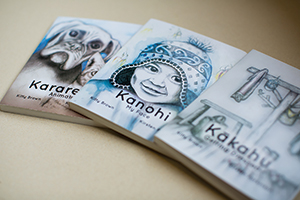 Kākahu, kanohi, kararehe.
Kākahu, kanohi, kararehe.
Nā te pūkeka o te rika toi me te pūmanawa o ēnei hākui o Reo Pēpi ki te whakanui i tō tātou reo, e toru kā take e areare mai kā tarika me te ōturu mai o kā karu o tāhaku pōtiki ia pō, ia pō. He pukapuka reo rua ēnei, ā, te mīharo hoki o te wāhaka akiaki ki muri, kai reira he kuputaka me ētahi tohutohu whakahua tika.
Ahakoa he iti o kā kupu kai rō ia pukapuka, he nui te kōrerorero i puta i a māua ko taku tama ia pō. Nō reira, he rauemi whakarauora reo, he rauemi whakarauora hinekaro Māori ēnei.
Hākui mā, hākoro mā – tēnā, hokona mai ēnei pukapuka kāmehameha.
These three delightfully-crafted bilingual bundles of pictures and words have been engaging the ears and eyes of my two-year-old at bedtime every night since we ordered our set online. These two amazing Kāi Tahu māmā (Kirsten Parkinson and Kitty Brown) have even thrown in a helpful section on correct pronunciation, and a glossary for good measure – which makes the books not just any ordinary story, but an enjoyable and easy-to-use language learning resource for our most basic users of te reo.
For more fluent speakers like my pōtiki and I, the pictures themselves provide plenty of opportunity for language extension through conversation. A wonderful reo resource for every whānau. Ka wani kē kōrua o Reo Pēpi!
Tamanui: Te Kōkako Mōrehu o Taranaki
Nā Rebecca Beyer rāua ko Linley Wellington
Huia Publishers
RRP: $23.00
Review nā Jeanine Tamati-Elliffe
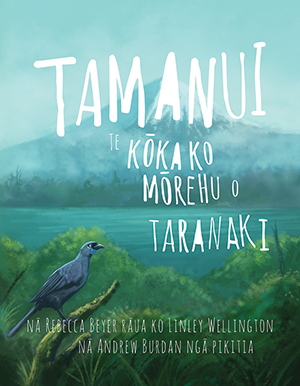 I whakamīharo āku tamariki ki te kōrero o tēnei kōkako, ko Tamanui. Nō te taeka mai o kā kararehe Pākehā, ka mōrearea haere te kāhere mō ēnei tūmomo manu o Taranaki. Nā wai, nā wai, ka karo haere te whānau o Tamanui, ā, manatu noa nei, ka noho mokemoke ia i tōna kāika – ko tērā pōhēhē tērā! Hai tōna kimihaka kāika rua, e kō mai ana tōna manawa ki te roko i te taki o tētahi kōkako hou… ekari he rauhaka noa iho, a, kua tāria kē! Mā te wā, ka whai whānau hou tēnei tamaiti o Tāne ki te haumarutaka o te takata.
I whakamīharo āku tamariki ki te kōrero o tēnei kōkako, ko Tamanui. Nō te taeka mai o kā kararehe Pākehā, ka mōrearea haere te kāhere mō ēnei tūmomo manu o Taranaki. Nā wai, nā wai, ka karo haere te whānau o Tamanui, ā, manatu noa nei, ka noho mokemoke ia i tōna kāika – ko tērā pōhēhē tērā! Hai tōna kimihaka kāika rua, e kō mai ana tōna manawa ki te roko i te taki o tētahi kōkako hou… ekari he rauhaka noa iho, a, kua tāria kē! Mā te wā, ka whai whānau hou tēnei tamaiti o Tāne ki te haumarutaka o te takata.
He autaia te pakiwaitara nei hai whakamahuki ki te tamaiti o te tāmitanga o te Pākehā ki te taiao me ā tātou kararehe Māori. Ahakoa he pōuri te tīmataka, he kōrero whakaohooho tonu tēnei i te whakaaro o te takata ki te kaupapa whakarauora kōkako ki Moki o Parininihi. Hai tāpirika, mai i te tauwhiro atu o te hoko i tēnei pukapuka, ka raupī atu koe ki te ope Tiaki Te Mauri o Parininihi. Kai whea mai!
My tamariki were amazed by this story about Tamanui and through this book increased their knowledge about the survival of one of our most endangered birds, the kōkako, since the arrival of predator animals in our forests. This story tells of how Tamanui became the last surviving member of his family – or so he thought. He sets off on a journey to find a new home when he hears new kōkako birdsong… however it was a trick and he was captured instead! In time, under the protection of the people of Ngāti Tama in Taranaki, Tamanui finds a new family and the kōkako of the Moki Forest can continue to regenerate once more.
This fantastic story offers us a way to discuss the impact of non-native predator animals on our environment, with our tamariki.
Despite the story’s sad beginning, we can also make a real and positive impact by supporting the regeneration of these manu, as all royalties from the sale of every book will contribute to the campaign aiming to bring back the kōkako to its native habitat in the forests in Taranaki.
 Jeanine Tamati-Elliffe (Kāi Te Pahi, Kāi Te Ruahikihiki nō Ōtākou) is a passionate reo advocate working in the area of child and maternal health. She has committed to raising her five tamariki in te reo Māori and is a founding member of Māori 4 Grown Ups, an organisation that supports more whānau to speak more reo to their tamariki.
Jeanine Tamati-Elliffe (Kāi Te Pahi, Kāi Te Ruahikihiki nō Ōtākou) is a passionate reo advocate working in the area of child and maternal health. She has committed to raising her five tamariki in te reo Māori and is a founding member of Māori 4 Grown Ups, an organisation that supports more whānau to speak more reo to their tamariki.
A History of New Zealand Women
Nā Barbara Brookes
Bridget Williams Books
RRP: $69.99
Review nā Anna Brankin
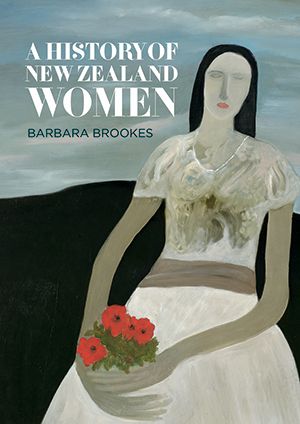 This vast and engaging book is the first example of a comprehensive history of this country that is written through an entirely female lens. It spans New Zealand’s history beginning with Polynesian settlement, passing through landmark eras such as European settlement, the Land Wars, and World Wars I and II, and concludes with an analysis of the status quo and the future this may lead to. Brookes recounts the achievements of many notable women such as Kate Sheppard, Jean Batten, and Arapera Kaa; stories which are set within the broader framework of nation-building, women’s rights, and the ongoing struggle for equality.
This vast and engaging book is the first example of a comprehensive history of this country that is written through an entirely female lens. It spans New Zealand’s history beginning with Polynesian settlement, passing through landmark eras such as European settlement, the Land Wars, and World Wars I and II, and concludes with an analysis of the status quo and the future this may lead to. Brookes recounts the achievements of many notable women such as Kate Sheppard, Jean Batten, and Arapera Kaa; stories which are set within the broader framework of nation-building, women’s rights, and the ongoing struggle for equality.
As the first self-governing country in the world to give women the vote (in 1893), New Zealand earned itself a reputation as a trailblazer in matters of gender equality. Brookes argues that the success of New Zealand’s suffragette movement was a result of the increased freedom and opportunities offered to European women in New Zealand during the colonial era. She shares the stories of women who emigrated to New Zealand to open their own businesses, taking advantage of the pressing need to support a quickly-growing society. Dressmakers and domestic servants were in particularly high demand, but women also owned milliners and grocery shops. New Zealand offered opportunities for independence that many women were denied by expectations of female domesticity and rigid social structures in England.
However, Brookes is careful to acknowledge that while European women enjoyed greater freedom, the opposite was true for Māori women. Colonisation, and the introduction of patriarchal family structures, disenfranchised Māori women in a very real way. Accustomed to a level of independence that meant they could own property and be active participants in their communities, Māori women were suddenly stripped of these rights with the introduction of European legislation. Dissatisfaction with gender inequality was a unifying factor for women throughout New Zealand during this era, regardless of their background.
Brookes’ narrative follows the trajectory of continual improvement that women have experienced since settlement, beginning with the suffragette movement in the late nineteenth century, and the more recent trend of women entering the workforce in ever-greater numbers. She concludes with thoughts on the future of New Zealand women, emphasising that issues such as equal pay, rape culture, and abortion laws still need to be addressed. This is an important book that celebrates the achievements of New Zealand women throughout history, and provides inspiration for the enactment of future change.
 Anna Brankin (Ngāi Tahu – Ōraka Aparima, Awarua and Puketeraki) is a Te Karaka Reporter within the Communications Team at Te Rūnanga o Ngāi Tahu. She previously spent 18 months on reception at Te Rūnanga o Ngāi Tahu. Before returning to Christchurch in 2015, Anna was studying English and PPE (Philosophy, Politics and Economics) at the University of Otago and working in a second hand bookstore.
Anna Brankin (Ngāi Tahu – Ōraka Aparima, Awarua and Puketeraki) is a Te Karaka Reporter within the Communications Team at Te Rūnanga o Ngāi Tahu. She previously spent 18 months on reception at Te Rūnanga o Ngāi Tahu. Before returning to Christchurch in 2015, Anna was studying English and PPE (Philosophy, Politics and Economics) at the University of Otago and working in a second hand bookstore.
The First Migration – Māori Origins 300BC–AD1450
Nā Atholl Anderson
BWB Texts 2016
RRP: $14.99
Review nā Gerry Te Kapa Coates
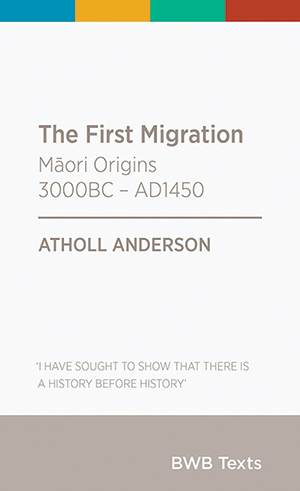 Many people know of the theory expounded in TV documentaries that Māori came through the Pacific via Taiwan. This book by Ngāi Tahu’s Atholl Anderson, co-author also of Tangata Whenua, is more of a monograph on an erudite topic, and reaches back even further to 5000 years ago.
Many people know of the theory expounded in TV documentaries that Māori came through the Pacific via Taiwan. This book by Ngāi Tahu’s Atholl Anderson, co-author also of Tangata Whenua, is more of a monograph on an erudite topic, and reaches back even further to 5000 years ago.
At this time, a group of people left South China and moved through the Asian archipelago, when the sea level was 60 metres lower than now. Anderson’s narrative looks at the evidential basis for what we now know, and how we know it: through radiocarbon dating, mitochondrial DNA, the location of strains of a human bacterial parasite, and stylistic changes in red-slipped Lapita pottery (interestingly, pottery was abandoned in favour of wooden vessels more suited to earth ovens).
It’s a fascinating though not always easy read, with the many end-notes needing to be read but breaking the flow, and many technical terms like haplotypes, cognatic kinship, and autochthonous, to name a few, but with no glossary or index. However, that aside, it is a very good story and summary laying out the evidence about why the Wairau Bar waka and moa-hunting site is so important in dating the probable arrival time at about AD 1150, and why whakapapa can also be relied on as an accurate if somewhat imprecise timeline tool.
Anderson says: “The status of Māori traditions as a source of historical evidence has been debated for more than 150 years, accepted or rejected at either extremes.” The traditions are consistent in terms of the period of migration, and although there appears to have been no “Great Fleet”, the facts do not support the idea that there were people in Aotearoa before Māori. He says unequivocally: “Polynesian seafarers were the first human inhabitants of New Zealand when they arrived about 800 years ago”, and this was a “common understanding of people throughout Polynesia.” However, he also gives little support to “the idea of Kupe and Toi arriving in the tenth or twelfth centuries respectively.”
He discusses the development of the vital technology of sail, and double-hulled canoes (“seemingly a Polynesian invention”) that dramatically allowed the advent of migrations into the remote eastern Pacific. He says: “It is probable that sailing reached Southeast Asia around 3,500–4,000 years ago.” However, he discounts Taiwan as being our principal origin, and suggests it is more “realistic” to regard the origin as a result of a conjunction of factors that coalesced around the Bismarck Islands of Papua New Guinea about 3500 years ago. As he says, “sailing into exile was generally a solution of last resort to problems of hunger, boundary disputes, personal feuds, and warfare”, and that “it is not difficult to imagine such scenes in the case of migration to New Zealand.” Downwind voyaging “would have been relatively easy and quite fast.” Anderson also discusses the difference between the mythological spiritual Hawaiki to the west, and Hawaiki as the origin of migrations being to the north-east of New Zealand.
This brief book fulfils its promise, and “gives an excellent sense of the lives of our Māori ancestors as they voyaged through centuries toward the South Pacific.”
Panguru and the City: Kāinga Tahi, Kāinga Rua An Urban Migration History
Nā Melissa Matutina Williams
Bridget Williams Books
RRP: $49.99
Review nā Gerry Te Kapa Coates
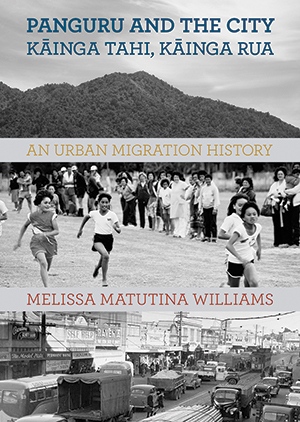 Melissa Williams was part of the urban migration in the middle of the 20th century following WWII, from Māori rural communities such as the one centred on Panguru on the west shore of the Te Hokianga-nui-a-Kupe and Auckland city. It was a major cultural shift which happened for many reasons, and this is a first-hand and thoroughly-researched story to help understand how and why it happened – and how connections with the home community were maintained. Williams points out that 1854 was a peak year for Māori selling their produce in Auckland, but ten years later a slump in markets and a hardening of settler attitudes following the outbreak of war in Waikato and Taranaki squeezed Māori out of the market. This heralded a new phase of colonialism led by voracious land sales, that “would render future generations homeless in their own land.” But in “a cruel twist of fate”, in 1952, the need for workers drew Māori from other tribal areas back to Tāmaki Makaurau, not as land owners but as factory hands and office workers.
Melissa Williams was part of the urban migration in the middle of the 20th century following WWII, from Māori rural communities such as the one centred on Panguru on the west shore of the Te Hokianga-nui-a-Kupe and Auckland city. It was a major cultural shift which happened for many reasons, and this is a first-hand and thoroughly-researched story to help understand how and why it happened – and how connections with the home community were maintained. Williams points out that 1854 was a peak year for Māori selling their produce in Auckland, but ten years later a slump in markets and a hardening of settler attitudes following the outbreak of war in Waikato and Taranaki squeezed Māori out of the market. This heralded a new phase of colonialism led by voracious land sales, that “would render future generations homeless in their own land.” But in “a cruel twist of fate”, in 1952, the need for workers drew Māori from other tribal areas back to Tāmaki Makaurau, not as land owners but as factory hands and office workers.
The book follows 42 individuals from Panguru who migrated to Auckland from the 1930s to 1970. It is lavishly illustrated with photographs, and underpinned by the interviews of the author for her doctoral research, which shaped “the framework, concepts and overall arguments” of her book. Williams was mindful that stories such as these can be both empowering and also a tool to “perpetuate negative Māori stereotypes or to determine what is best for Māori communities.” The destructive approach from Māori leading to official policies of assimilation and integration was at odds with research by anthropologists and social scientists such as Keesing, Sutherland, and the Beagleholes, who were generally in favour of more constructive policies respecting Māori culture.
The 1960 Hunn Report’s recommendations were major – some would say last ditch – attempts to embed assimilation in a Māori policy that would be “ complete when Māori attachment to their homelands and culture was severed.” In 1952 the Māori Women’s Welfare League revealed Māori were living in Auckland in “atrocious conditions”, with an urgent need for better housing, something which still haunts us today. The stories in the book reflect the attempt by migrants to Auckland to transform an unfamiliar inner-city environment into a home for their families, where the values and goals they brought from Panguru were supported by cultural forces like whānau, whakapapa, and the ties of religious faith to provide a solid framework. It was important that whānau also had their elders alongside the parents and children of this new urban community whenever possible. Racism became a movable feast, as the Ākarana Māori Association joined the frenzy of “moral panic” over assimilation to align with the anti-Asian White New Zealand League in a fragile arrangement.
Life was different in a Pākehā dominated city – housing, food and even using Te Reo – and sometimes it was only visitors from Panguru who reminded them of their roots, by being able to use Te Reo freely. How did it all end? Williams says, “To have found beauty amidst daily discrimination and coercive state policies required optimism about their futures… and the ability to accept if not be happy with their lot in life.” For the people of the Panguru hapū, it meant surmounting these challenges for themselves and future generations, and ultimately having that “beautiful ending”.
 Gerry Te Kapa Coates (Ngāi Tahu, Waihao) was born in Ōāmaru, and is an author of poetry – a collection of poems and short stories called The View From Up There (2011) – and widely varied non-fiction. He is a consultant working on hearings as a commissioner and Māori advisory work.
Gerry Te Kapa Coates (Ngāi Tahu, Waihao) was born in Ōāmaru, and is an author of poetry – a collection of poems and short stories called The View From Up There (2011) – and widely varied non-fiction. He is a consultant working on hearings as a commissioner and Māori advisory work.
Opinions expressed in REVIEWS are those of the writers and are not necessarily endorsed by Te Rūnanga o Ngāi Tahu.